Australia goods and services exports rose 6% mom or AUD 2443m to AUD 42.23B in May. Goods and services rose 3% mom or AUD 919m to AUD 32.55B. Trade surplus widened to AUD 9.68B, up from AUD 8.16B, smaller than expectation of AUD 10.50B.
Australia AiG manufacturing rose to record 63.2, strength of recovery continued
Australia AiG Performance of Manufacturing Index rose to new record high at 63.2 in June, up from 61.8. That’s also the ninth consecutive month of rise. Looking at some more details, production dropped -3.8 to 60.7. Employment dropped -1.0 to 60.3. New orders jumped 5.7 to 70.6. Supplier deliveries rose 6.7 to 58.3. Exports rose 11.3 to 60.2. Input prices dropped -3.3 to 78.8. Selling prices rose 5.3 to 63.6.
Ai Group Chief Executive Innes Willox said: “The 2020-21 financial year closed on a high note for Australia’s manufacturing sector. Ai Group’s June Australian PMI pointed to record growth across the sector fueled by the fastest recorded pace of expansion in each of the food & beverages; machinery & equipment; building materials; and chemicals sectors. Production, employment, and sales exports were all higher than in May although the rate of acceleration generally eased. Exports of manufactured goods surged in June and new orders were also higher, pointing to the likelihood of further expansion in the months ahead. The strength of the recovery continued despite headwinds from COVID outbreaks and associated lockdowns and border restrictions, high freight costs and the widespread difficulties employers are experiencing in filling positions.”
Canada GDP contracted -0.3% mom in Apr, first decline in a year
Canada GDP contracted -0.3% mom in April, better than expectation of -0.80%. That’s the first contraction after 11 consecutive monthly growth. Total economic activity remains about -1% below its pre-pandemic level in February 2020.
12 of 20 industrial sectors were down. Good producing industries’ 0.5% gain were more than offset by -0.6% mom contraction in services-producing industries.
Preliminary information indicates a further -0.3% mom contraction in real GDP in May.
US ADP jobs grew 692k, services doing the heavy lifting
US ADP employment grew 692k in June, above expectation of 600k. By company size, small businesses added 215k jobs, medium businesses added 236k, large businesses added 240k. By sector, goods-producing jobs grew 68k, service-providing grew 624k.
“The labor market recovery remains robust, with June closing out a strong second quarter of jobs growth,” said Nela Richardson, chief economist, ADP. “While payrolls are still nearly 7 million short of pre-COVID-19 levels, job gains have totaled about 3 million since the beginning of 2021. Service providers, the hardest hit sector, continue to do the heavy lifting, with leisure and hospitality posting the strongest gain as businesses begin to reopen to full capacity across the country.”
BoE Haldane warns of Minsky Moment for monetary policy
BoE Chief Economist Andy Haldane said he in a speech he expected UK inflation to be “near 4% than 3%” by the end of this year. “This increases the chances of a high inflation narrative becoming the dominant one, a central expectation rather than a risk.” Inflation expectations would then “shift upward”.
“We would experience a Minsky Moment for monetary policy, a taper tantrum without the taper,” he warned “This would leave monetary policy needing to play catch-up to re-anchor inflation expectations through materially larger and/or faster interest rate rises than are currently expected.”
Different from the Global Financial Crisis, he said “time that policy script feels stretched.”. And, “the pace of recovery is significantly faster now than then, bouncing rather than edging back.” He warned, “a slow exit risks putting central bank balance sheets on an unsustainable footing”.
Overall, Haldane said, “in my view it does, however, call for immediate thought, and action, on unwinding the QE currently being provided, given the state of the economy and central banks’ balance sheets.”
Eurozone CPI slowed to 1.9% in Jun, core CPI ticked down to 0.9%
Eurozone CPI slowed to 1.9% yoy in June, down from 2.0% yoy, matched expectations. Core CPI closed to 0.9% yoy, down from 1.0% yoy, matched expectations.
Looking at the main components, energy is expected to have the highest annual rate in June (12.5%, compared with 13.1% in May), followed by non-energy industrial goods (1.2%, compared with 0.7% in May), services (0.7%, compared with 1.1% in May) and food, alcohol & tobacco (0.6%, compared with 0.5% in May).
Swiss KOF dropped to 133.4, prospects remains very positive
Swiss KOF economic barometer dropped to 133.4 in June, down from all-time high at 143.7, missed expectation of 145.3. The barometer still lies well above its long-term average. KOF added, “the prospects for the Swiss economy remains very positive, provided that the economy is not severely affected by a renewed spread of the virus.”
France consumer spending rose 10.4% mom in May, close to pre-pandemic average
France consumer spending rose sharply by 10.4% mom in May, above expectation of 8.9% mom, more than enough to reverse -8.7% mom decline in April on return to lockdown. The rebound was mainly driven by manufactured goods purchases (+26.0%), with the reopening of all stores on May 19, and to a lesser extent by spending on energy (+2.6% after a stability), with the end of travel restrictions in early May. Food consumption was stable. Spending in May was at a level near to the average of Q4 2019, just down -0.3%.
Also released, CPI came in at 0.2% mom, 1.9% yoy in June, versus expectation of 0.2% mom, 1.8% yoy.
UK Q1 GDP finalized at -1.6% qoq, -8.8% below pre-pandemic level
UK Q1 GDP contraction was finalized at -1.6% qoq, revised from first estimate of -1.5% qoq fall. The level of GDP was -8.8% below the pre-pandemic level at Q4 2019.
Services contracted -2.1% qoq, and was at -8.8% below Q4 2019. Production contracted -0.5% qoq, at -3.7% below Q4 2019. Construction grew 2.3% qoq, still -3.7% below pre-pandemic levels.
New Zealand ANZ business confidence dropped to -0.6, enormous cost pressures
New Zealand ANZ business confidence dropped to -0.6 in June, down from May’s 1.8. Own activity outlook rose to 31.6, up form 27.1. Looking at some details, export intentions rose form 12.2 to 13.4. Investment intentions rose from 18.9 to 25.5. Cost expectations rose from 81.3 to 86.2. Employment intentions dropped from 20.5 to 19.7. Pricing intentions rose from 57.4 to 62.8. Inflation expectation jumped further from 2.22% to 2.41%.
ANZ said: “The New Zealand economy is stretched, and firms are clearly facing enormous cost pressures. Increasingly, they are planning on raising their prices in response, with little fear evident that demand will collapse as a result. Shortages of labour are driving investment decisions to a greater extent, but it’s confidence in the economic outlook that will always be key here.
With firms keen to invest and employ, and both cost-push and demand-pull factors suggesting strong inflation ahead, it’s past time to unwind the emergency OCR stimulus. We are forecasting the RBNZ to raise the OCR in February next year, but odds are rising that we’ll see hikes this year.”
China PMI manufacturing dropped to 50.9 in Jun, PMI non-manufacturing dropped to 53.5
China official PMI Manufacturing dropped slightly to 50.9 in June, down from 51.0, above expectation of 50.7. Production index dropped from 52.7 to 51.9, hitting a four-month low. Total new orders rose from 51.3 to 51.5. But new export orders dropped further from 48.3 to 48.1. Raw material costs eased from 72.8 to 61.2, after the government’s crackdown on prices.
PMI Non-Manufacturing dropped to 53.5, down from 55.2, below expectation of 50.7.
Fed Waller: Appropriate to start thinking about pulling back some stimulus
Fed Governor Christopher Waller told Bloomberg TV yesterday that “the unemployment rate would have to drop fairly substantially, or inflation would have to really continue at a very high rate, before we would take seriously a rate hike in 2022”. Nevertheless, “I’m not ruling it out,” he added.
The US is now in a “different phase of economic policy,” he noted. Hence, ” it’s appropriate to start thinking about pulling back on some of the stimulus.” He’d be “all in favor” to phase out MBS purchases first, as “right now the housing markets are on fire; they don’t need any other unnecessary support.”
“I think everybody anticipates that tapering could move up earlier than when they originally thought,” Waller said. “Whether that’s this year, we’ll see, but it certainly could.”
“I myself would like to see tapering over before we consider raising rates; therefore if you think you may have to raise rates in late ’22 or early ’23, you pretty much want to get tapering done by the end of next year if possible,” he said.
Gold downside breakout, heading back to 1676 support
Gold’s fall from 1916.30 resumes today by breaking through 1760.71. Further fall is now expected as long as 1794.75 resistance holds. Deeper decline should be seen back to 1676.65 support, which is close to 38.2% retracement of 1046.27 to 2074.84 at 1681.92. We’d expect strong support from there to bring rebound.
However, sustained break of 1676.65 will argue that it’s in a larger scale correction. Deeper fall could then be seen to 61.8% retracement at 1439.18 in the medium term.
US consumer confidence rose to 127.3 in Jun, highest since Mar 2020
US Conference Board Consumer Confidence rose to 127.3 in June, up from 120.0, above expectation of 119.3. That’s also the highest level since March 2020. Present Situation Index rose from 148.7 to 157.7. Expectations Index rose from 100.9 to 107.0.
“Consumer confidence increased in June and is currently at its highest level since the onset of the pandemic’s first surge in March 2020,” said Lynn Franco, Senior Director of Economic Indicators at The Conference Board.
“Consumers’ assessment of current conditions improved again, suggesting economic growth has strengthened further in Q2. Consumers’ short-term optimism rebounded, buoyed by expectations that business conditions and their own financial prospects will continue improving in the months ahead. While short-term inflation expectations increased, this had little impact on consumers’ confidence or purchasing intentions. In fact, the proportion of consumers planning to purchase homes, automobiles, and major appliances all rose—a sign that consumer spending will continue to support economic growth in the short-term. Vacation intentions also rose, reflecting a continued increase in spending on services.”
BIS: Policymakers need to set a solid foundation for long-term growth
The Bank for International Settlement said in its Annual Economic Report that “swift and forceful action from central banks and governments has limited the economic damage from the Covid-19 pandemic”. But in the coming year, “issues such as corporate insolvencies and capital and labour reallocation will come to the fore.”
Agustín Carstens, General Manager, said: “The whole world entered this crisis suddenly and as one, but the exit is proving to be slower and staggered. While the recovery has been faster and stronger than anyone would have imagined a year ago, we are not out of the woods yet. Policymakers need to carefully manage the risks arising from this economic and policy divergence and set a solid foundation for long-term growth.”
He added: “As we exit the pandemic, we see higher public debt, lower interest rates and larger central bank balance sheets. Normalising monetary and fiscal policy over the longer term will provide a necessary safety margin to cope with unexpected events such as the pandemic or future recessions. And securing a durable recovery will require addressing the more lasting consequences of the pandemic.”
AUD/JPY and NZD/JPY in sharp fall after failing 55 day EMA
AUD/JPY and NZD/JPY are two of the biggest movers today. AUD/JPY’s rebound from 82.11 could have completed at 89.24, after failing to sustain above 55 day EMA (now at 84.01). Deeper fall could now be seen through 82.11 to extend the correction from 85.78. At this point, we’d continue to expect strong support from 38.2% retracement of 73.12 to 85.78 at 80.94 to bring rebound. However, sustained break of 80.94 would argue that it’s correcting whole up trend from 59.85, and bring deeper fall to 78.44 resistance turned support.
Similarly, NZD/JPY’s rebound from 76.20 should have completed at 78.46 after failing to sustain above 55 day EMA (now at 78.09). Deeper fall could be seen through 76.20 support to extend the correction from 80.17. We’d still expect strong support from 38.2% retracement of 68.86 to 80.17 at 78.54 to bring rebound. However, sustained break of 78.54 would argue that it’s correcting whole up trend from 59.49. and bring deeper fall to 71.66 resistance turned support.
Eurozone economic sentiment rose to 117.9, a 21-year high
Eurozone Economic Sentiment Indicator rose strongly to 117.9 in June, up from 114.5. The ESI outstrips its long-term average and pre-pandemic level, hitting a 21-year high. Employment Expectation Indicator rose by 1.6 pts to 111.6, highest since November 2018. Industrial confidence rose from 11.5 to 12.7. Services confidence rose from 11.3 to 17.9. Consumer confidence rose from -5.1 to -3.3. Retail trade confidence rose from 0.5 to 4.5. Construction confidence rose from 4.9 to 5.1.
EU ESI rose 3.0 pts to 117.0, a 21-year high. EEI rose 1.2 pts to 111.5, highest since November 2018. At the country level, the ESI reached an all-time high in Germany (+5.0) and increased also in Italy (+2.1), the Netherlands (+1.9), France (+1.3) and Poland (+0.2). Of the six largest EU countries, only Spain saw a slight decline (-1.1).
RBNZ Orr: Policy settings expected to normalize over medium term
RBNZ Governor Adrian Orr said in a Statement of Intent that economic activity in New Zealand is “returning to its pre-COVID-19 levels”, supported by “ongoing favourable domestic health outcomes, and improving global demand and higher prices for New Zealand’s goods and exports”.
“A catch-up in consumer spending and construction activity, supported by substantial monetary and fiscal stimulus is underpinning employment growth,” he added.
“As long as COVID-19 is contained and the global and economic recovery is sustained, eventually economic policy settings can be expected to normalize over the medium term.”
Fed Quarles: We’re not behind the curve on inflation
Fed Vice Chair Randal Quarles said that the current high inflation was transitory, due to supply chain imbalances and higher demand. He said, “if a year from now we were not to see inflation settling back down to something that’s closer to our 2% target… we have the tools at the Fed to then begin – as we traditionally would – to increase interest rates, to change our monetary policy in a way that would address that inflation.” He noted that “we’re not behind the curve”.
Separately, Richmond Fed President Thomas Barkin said, “it’s pretty clear to me we have had substantial further progress against our inflation goal”. “I’m pretty optimistic about the labor market. … If the labor market opens as I suggested it might, then I think we’re going to get there in relatively short order.”
“I kind of think let’s look at it next year and see what happens and if the numbers hit, great, if they don’t, we’ve got time because it will show there’s still more time for the economy to grow,” Barkin said.



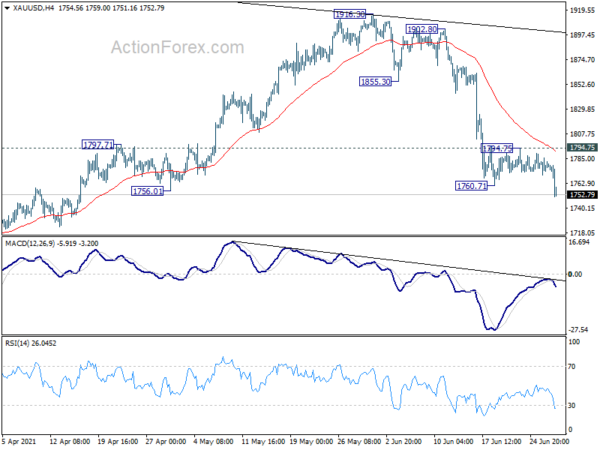
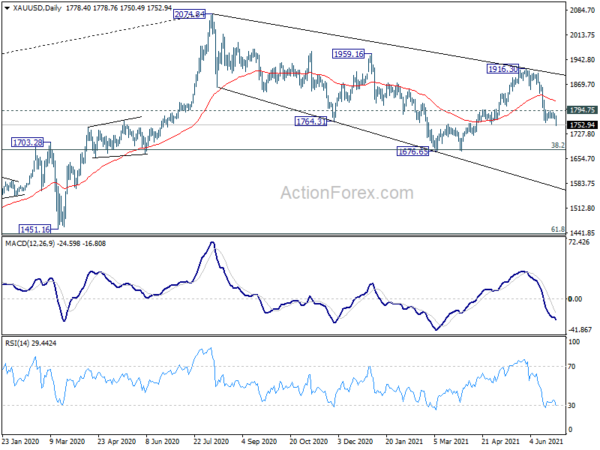





China Caixin PMI manufacturing dropped to 51.3, gradually returned to normal
China Caixin PMI Manufacturing dropped to 51.3 in June, down from 52.0, below expectation of 51.8. Markit noted increase in output was softest for 15 months. Total new order growth slowed as export sales stagnated. Employment continued to inc rea sew while cost pressures eased.
Wang Zhe, Senior Economist at Caixin Insight Group said: “Overall, the manufacturing sector continued to stably expand in June, despite the impact of the pandemic…. The manufacturing sector has gradually returned to normal. In the second half of this year, the low base effect from last year will weaken. Inflationary pressure, coupled with the economic slowdown, is still a serious challenge for China.”
Full release here.